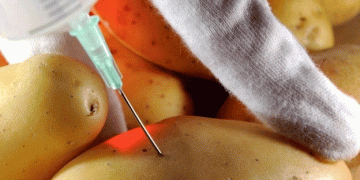Invisible inefficiencies, says Heat and Control’s Clark Hicks, can severely hamper the productivity of a packaging operation. In this article for Potato Processing International, he examines ways to improve efficiency.
In this day and age, many processors in our industry are focused on improving efficiency throughout their whole operation to ultimately improve their bottom line.
While there are many obvious areas too improve efficiency in a food production facility, one that is often overlooked, as it is not readily visible, is improved packaging efficiency through the use of a quality feed system to packaging.
This article will out line several situations in which a packaging line is running inefficiently, but the problem is not readily visible.
A common misconception by plant personnel is that the bags per minute listed on the screen of the bagger are actually what the bagger is producing; as long as bags are steadily coming off of the machine.
The real measuring stick for production should be the actual bags produced per shift and then divided out into bags per minute.
There are inefficiencies that are not readily visible, which can cause the bags per minute figure to be much less at the end of the day, than the actual speed setting on the bagger.
The first situation we will discuss is a weigher in a starved condition.
A weigher in a starved condition means there is not enough product being delivered to the weigher to keep it satisfied and running correctly.
On a 14-head computer combination weigher (CCW), the desired number of buckets used per weighment is three to five.
In a starved condition, the weigher may use up to 10 buckets of the 14 available to make a good weight. In doing this, it causes the weigher to slow down dramatically because it is always waiting on product to re-fill a majority of the buckets before it can produce another good weight.
The ultimate price for this is a dramatic drop in overall bag speed and, in turn, an outcome of lower overall efficiency.
In other words, due to this slower operation, cycles will be missed.
The second situation would be just the opposite of the first: being a weigher in a flooded or overfed state.
OVERFED WEIGHERS
If the weigher is overfed, then a reduced number of the desired 3-5 buckets will be used to make the desired weight.
The problem with this situation is strictly excessive giveaway and/or rework due to the loss of weight control by not having enough buckets to make a good target weight.
The third situation would be incorrect alignment of the crossfeeder feeding the weigher.
In this case, the crossfeed conveyor is either too far past the centre of the dispersion cone on the weigher, or not close enough.
In both scenarios, the end result is that half of the weigher is fed product and the other half is not.
The cost of this is reduced speed due to only half of the 14 buckets having product in them to produce the correct weight which slows the overall process down tremendously.
To sum it up, this condition is actually a combination of the problems that occur in the first two situations.
Now, how can this problem be corrected?
Better operators? Better management of systems? Better equipment?
You will be happy know, the answer is YES!
The largest ROI available is an improved feed system to keep the weigher satisfied correctly and keep product landing on the centre of the weigher so it is evenly distributed to all the buckets on the machine.
There are multiple types of feed systems available in the market, but there is one type, a proportional feed system, which is at the forefront of product handling technology.
A proportional feed system provides the best efficiency available today because it adjusts itself over time to keep the weigher feed conveyors operating as close to 100 per cent of the time as possible, providing the optimum result.
The gates in a proportional feed system are design to have an infinite amount of opening sizes rather than traditional gates which are either completely open or completely closed.
The proportional gates also allow product to be fed in two directions at the same time which was not previously achievable with traditional end gates.
The proportional feed system constantly measures the incoming product to each gate providing feedback; this allows the system to calculate the current throughput.
Once the control system knows the throughput it can adjust the gates to allow the correct percentage of the current line flow to each weigher, which is especially important when a plant wants high efficiency feed to the weighers and/or is running multiple bag sizes at the same time.
The demand of the weighers is based on initial operator input and then the control system works to keep the weigher satisfied on the fly.
In order to keep the system in continuous proportional mode, some type of accumulation (one of several methods) or recirculation is required.
Any product passing the last weigher will go into the recirculation loop and either be bulked off or be put back into distribution between the first and second weigher positions OR the accumulation system will absorb any momentary unwanted product.
PREVENT OVERFEEDING
The recirculation loop adds back between the first and second positions so the system has a chance to pull product off of the line with the first position, before re-introducing product so the distribution line does not become flooded with product under high throughput scenarios.
In the market today, the availability of sophisticated communication between all the equipment greatly improves the overall performance of a system.
The proportional gate system prevents overfeeding and starving based on the fact it is in constant adjustment and can correct either condition based on the weigher’s demand for product.
During installation the correct alignment of the weigher feeder over the scale insures product is falling right in the centre of the weigher, but if the product bed depth in the weigher feeder changes dramatically, it will cause product to be feed past the centre (high bed depth) or fall short of the centre (low bed depth)
The proportional feed system will keep the bed depth constant so product will always fall in the centre of the weigher and be evenly distributed to all the weigher buckets.
So, to summarise, improved packaging efficiency and therefore throughout the whole operation can lead to improved productivity and improved bottom line profits.
The bottom line: do not starve or overfeed the weigher and the best way to get it just right is a proportional feed system.





